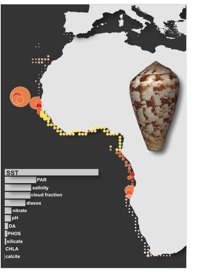THE R2C2 LAB

Research the R2C2 lab


Island speciation

Atlantic oceanic archipelagos provide an excellent model system for studying gradients of species diversity and phylogenetic patterns over evolutionary time scales, given their similar geological age and the availability of paleoclimatic and bathymetric data.
We have concentrated our efforts in a highly speciose genus, Conus, with more than 50 endemic species described from Cape Verde.
Cunha RL, Lima FP, Tenorio MJ, Ramos AA, Castilho R, Williams ST (2014) Evolution at a different pace: distinctive phylogenetic patterns of cone snails from two ancient oceanic archipelagos. Systematic Biology, 63(6):971–987.
Cunha RL, Tenório MJ, Afonso C, Castilho R, Zardoya R (2008). Replaying the tape: recurring biogeographical patterns in Cape Verde Conus after 12 million years. Molecular Ecology, 17 (3): 885-901.
Cunha RL, Castilho, R Rüber, R and Zardoya, R (2005). Patterns of Cladogenesis in the Venomous Marine Gastropod Genus Conus from the Cape Verde Islands. Systematic Biology, 54(4):634–650. (IF – 10.523; Ranking - Evolutionary Biology – 2/33).

Past and present structure of small pelagics
We study the genetic patterns of leading-edge populations in the European anchovy, Engraulis encrasicolus, and its American counterpart, Engraulis eurystole, as part of an emerging effort to understand the role played by climatic fluctuations in shaping the geographical distributions and abundances of marine organisms. Moreover, the European anchovy provides an ideal system to investigate adaptive selection, as it is distributed throughout tropical, subtropical and cold-temperate coastal areas, facing contrasting environmental features, which implies an impressive tolerance to a broad range of temperatures and salinities.
Castilho R, Silva G 2016. The European anchovy, a genetically highly diverse species displays null within-sample haplotype diversity on a single study? Mitochondrial DNA 1:66–67.
Silva G, Horne JB, Castilho R 2014. Anchovies go north and west without losing diversity: post-glacial range expansions in a small pelagic fish. Journal of Biogeography, 41:1171–1182.
Silva G, Lima FP, Martel P, Castilho R 2014. Thermal adaptation and clinal mitochondrial DNA variation of European anchovy. Proceedings of the Royal Society of London. Series B: Biological Sciences 281:20141093–20141093.





Biogeography and phylogeography of the Atlantic
We study the genetic patterns of leading-edge populations in the European anchovy, Engraulis encrasicolus, and its American counterpart, Engraulis eurystole, as part of an emerging effort to understand the role played by climatic fluctuations in shaping the geographical distributions and abundances of marine organisms. Moreover, the European anchovy provides an ideal system to investigate adaptive selection, as it is distributed throughout tropical, subtropical and cold-temperate coastal areas, facing contrasting environmental features, which implies an impressive tolerance to a broad range of temperatures and salinities.
Stefanni S, Castilho R, Sala-Bozano M, Robalo JI, Francisco SM, Santos RS, Marques N, Brito A, Almada VC, Mariani S 2015. Establishment of a coastal fish in the Azores: recent colonisation or sudden expansion of an ancient relict population. Heredity, 115 (6):1–11.
Zardi GI, Nicastro KR, McQuaid CD, Castilho R, Costa J, Serrao EA, Pearson GA 2015. Intraspecific genetic lineages of a marine mussel show behavioural divergence and spatial segregation over a tropical/subtropical biogeographic transition. Estuarine, Coastal and Shelf Science. 15 (1):1–11.
Maggs CA, Castilho R, Foltz D, Henzler C, Jolly MT, Kelly J, Olsen J, Perez KE, Stam W, Vainola R, others 2008. Evaluating signatures of glacial refugia for North Atlantic benthic marine taxa. Ecology 89:108–122.
Patarnello T, Volckaert FA, Castilho R 2007. Pillars of Hercules: is the Atlantic--Mediterranean transition a phylogeographical break? Molecular Ecology 16:4426–4444.





